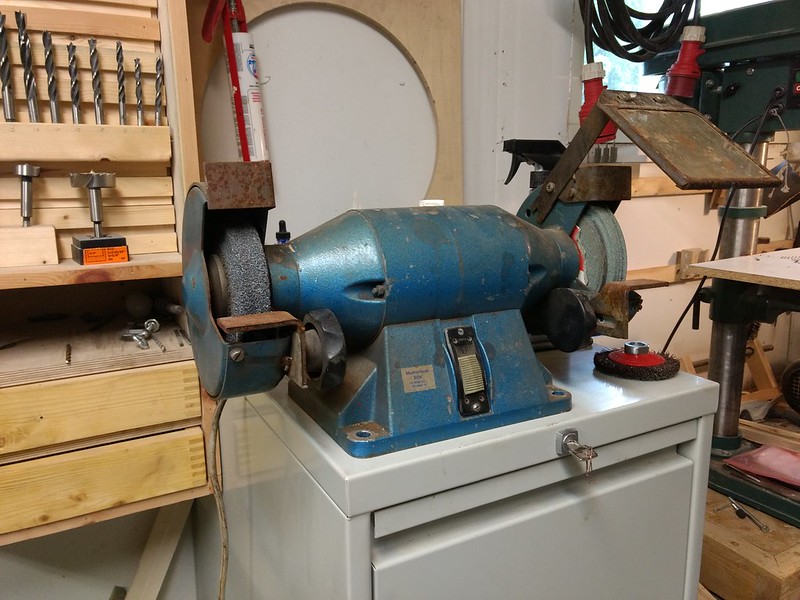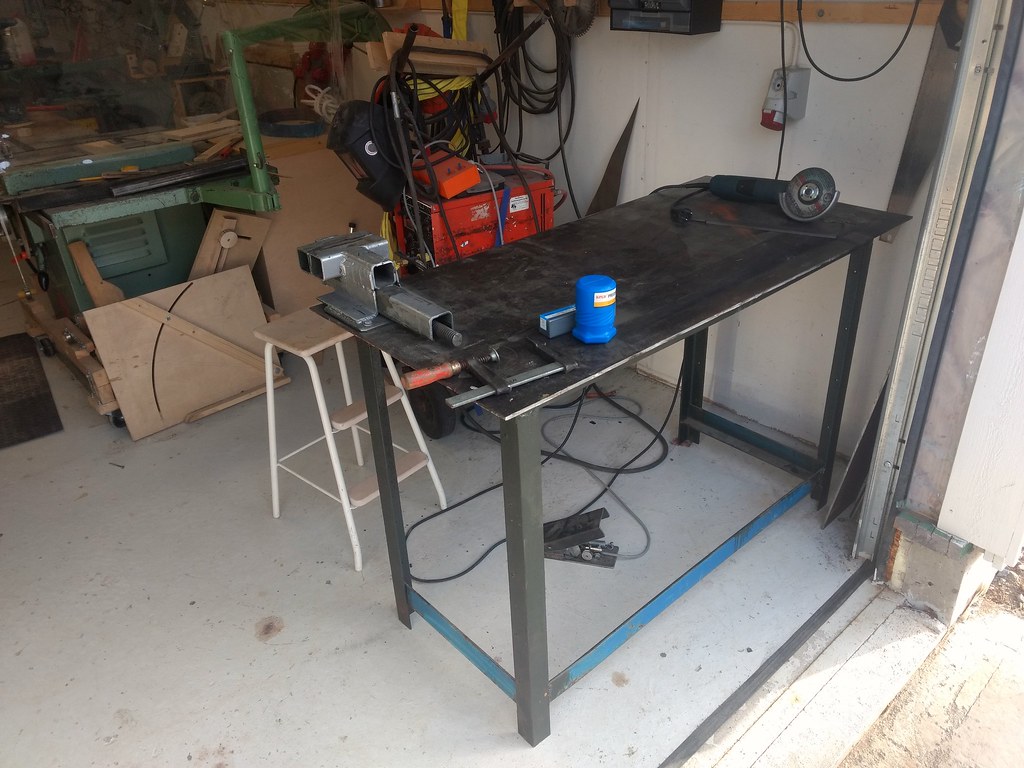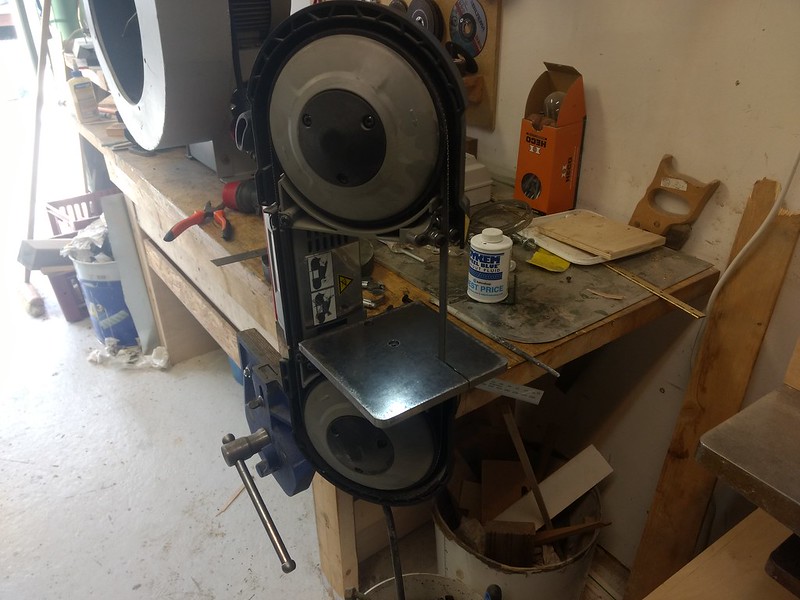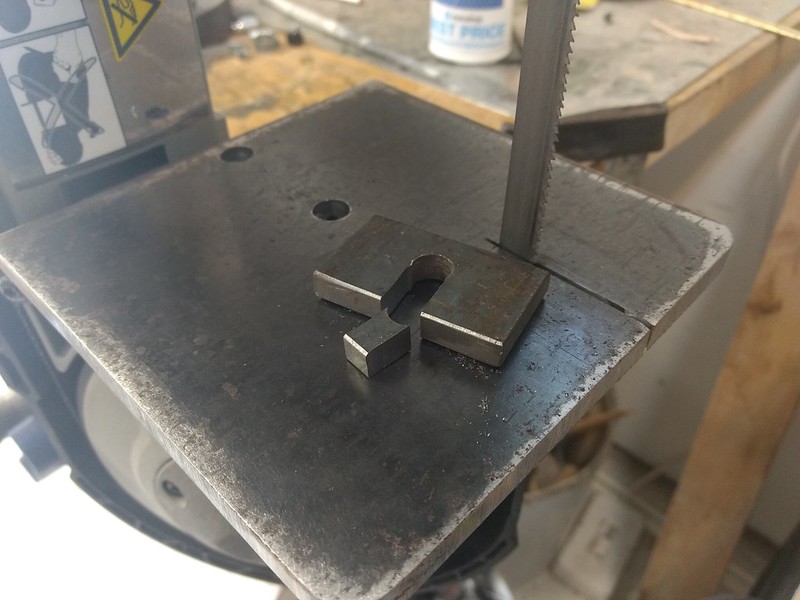|
I've been realizing lately how inadequate some of my machining education is (OK, I'm mostly self-taught so oh well) because I legitimately am not sure how one uses threading dials. I've so far been doing threading by backing the tool out and switching direction on the lathe.
|
|
|
|

|
| # ? May 9, 2024 21:11 |
|
mekilljoydammit posted:I've been realizing lately how inadequate some of my machining education is (OK, I'm mostly self-taught so oh well) because I legitimately am not sure how one uses threading dials. I've so far been doing threading by backing the tool out and switching direction on the lathe. You flip the handle up on any number and it will lock in to a feed screw at the proper orientation to follow your thread.
|
|
|
|
The threading dial essentially just reports the angle of the leadscrew. As the screw turns, the dial rotates and tells you what part of the thread is currently engaged with the half nuts on the carriage. If you always engage the half nuts at the same point on the leadscrew thread, then you'll cut the same pattern every time. Some threads can be engaged at multiple points depending on their mathematical ratios; for instance, your threading chart might say that you can use any mark on the dial for even threads, but only the numbered marks for odd threads, or something. In order to use it properly, you need one additional piece, which is a sliding stop that allows you to retract the tool with the cross slide all the way, but which stops it from moving in to the center beyond some point. Then what you do is: 1) set your thread pitch on the gearbox 2) throw the back gears into mesh or run at the lowest possible speed 3) align your tool perfectly square to the part using a fishtail gauge 4) set your compound rest at 29 degrees (for a 60 degree thread), as this is the correct angle of advance for this type of cut 5) bring the threading tool to the beginning of the section to be threaded 6) using the cross slide, advance the tool in until it's just marking the surface 7) set your sliding stop so that the cross slide cannot move any closer than this point (the cutting advance will be done with the compound rest) 8) turn the lathe on, pick a number on the thread dial, and when that number passes the mark, quickly throw the half nuts into mesh. the lathe will cut a thread 9) at the end of the section, disengage the carriage and pull the tool straight out using the cross slide 10) check your work and make sure that the faint spiral you've just cut has the correct pitch 11) if it's correct, bring the tool back to the start using the handwheel, then turn the cross-slide back in until you hit the stop. if you did this right, you should be skimming the surface of your previous cut without cutting anything. (note that it's also perfectly fine to bring the tool past the start, so that the next thread starts in air -- the dial will take care of it) 12) turn the compound rest in a small amount, .005 or whatever, advancing the tool forwards at an angle to increase the depth of cut 13) wait for the same number you used before to come around on the threading dial again, and when it does, throw the half nuts into mesh 14) cut the next pass of the thread 15) return to step 9 and repeat until you have cut to the proper depth. Note that you only advance using the compound rest and only retract using the cross slide. That's how you eliminate backlash and maintain accuracy across many passes, even when cutting tiny threads. I say to use the same number on the dial for every pass; again, depending on the specific thread you're cutting you may be able to use all eight markings, every other one, only two on opposite sides of the dial, or only the same number each time. That can save time if you're cutting a lot of threads. It will always work correctly if you stick to the same number though. And that's it! Easy! 
Sagebrush fucked around with this message at 16:11 on Jun 1, 2018 |
|
|
|
Sagebrush posted:The threading dial essentially just reports the angle of the leadscrew. As the screw turns, the dial rotates and tells you what part of the thread is currently engaged with the half nuts on the carriage. If you always engage the half nuts at the same point on the leadscrew thread, then you'll cut the same pattern every time. Some threads can be engaged at multiple points depending on their mathematical ratios; for instance, your threading chart might say that you can use any mark on the dial for even threads, but only the numbered marks for odd threads, or something. Excellent writeup!
|
|
|
|
Oh. I know you're making fun of things when you call it easy, but that's actually... not too complicated. Suppose this means I need to see if my South Bend actually needs refurbishment or if I was just a lot worse at using a lathe last time I used it. *edit* And because I'm a dumbass, thank you, that laid out a bunch of stuff I hadn't considered for doing threads.
|
|
|
|
The most important things to get good threads are, in my experience, 1) go SLOW. You're cutting with a razor-sharp pointed tool that will deflect or break quickly if you push it too hard. The lowest possible speed is the right one. 2) use lots of cutting fluid or oil, again because of the size of the tool and the pressures involved. 3) really make sure that you have your compound rest set accurately to 29 degrees (some people say 29.5, but never 30 and never 0/90). Advancing the tool at the wrong angle is akin to turning a part with the tool's lead angle set wrong, and you'll get chattering or galling or whatever else.
|
|
|
|
Joe Pieczynski had some nice videos on threading IMO.
|
|
|
|
I was phone posting earlier and couldn't find these videos. Here are two excellent videos for you. One on threading and one on explaining the threading dial. https://www.youtube.com/watch?v=f2y36EGHpts https://www.youtube.com/watch?v=jbRcs_Hhtuw
|
|
|
|
So, question. A little while ago I waterjet cut some A2 knife blanks for a goon. Just wondering if there are any practical differences from making a knife out of a piece of .125 plate stock vs forging one from a bigger chunk of steel.
|
|
|
|
A Proper Uppercut posted:So, question. A little while ago I waterjet cut some A2 knife blanks for a goon. Yes, forging moves the metal grain into the final shape. There is a structure under the outside geometry that is holding that shape together. Forging flattens and stretches the crystal structure to improve the strength of the final shape. That plate was probably rolled and ground so it had a grain close to parallel with the ground surface like pages in a book. Now think about grinding the pages away to make an edge: the pages are still straight columns and will support the edge, but If it were forged into a knife shape, we'd have almost the same number of columns and they would be thinner, bending towards the edge, providing more support. Here are some explainations https://www.scotforge.com/Why-Forging/Forging-101/Forging-Advantages
|
|
|
|
While that's certainly the case for pieces that undergo minimal or no post-shaping heat treatment, doesn't normalizing and annealing largely negate it in the case of knives?
|
|
|
|
TerminalSaint posted:While that's certainly the case for pieces that undergo minimal or no post-shaping heat treatment, doesn't normalizing and annealing largely negate it in the case of knives? That's what I was think too.
|
|
|
|
Is anyone here well versed in anodizing? I'm trying to figure out how to suspend my die with minimal impact to finish. I found I can get 1/8" aluminum sculpting wire, and figured I can either make a stand to support the whole thing with supports touching in four pips (the 4,5,or 6 sides), or I can try to make something that can grip it by two pips on opposite sides (2/5 or 3/4 faces) and suspend it. I'm not really sure which way to go and I've got it so bright and shiny right now and don't want to ruin that (either by scratching it before anodizing or by doing a poo poo job anodizing).
|
|
|
|
|
Another tool I've been keeping an eye out for. I was aiming originally for something bigger but went with this because it was so near me. 230v single phase, runs really smooth though I want to give it a cleanup. Guy who sold it said it was his fathers, who had amassed several tools he never used.  It has ports for dust collection too, I wonder if I need to get a spark trap of some kind to use it with my shop vac (full of wood dust).
|
|
|
|
Mr. Powers posted:Is anyone here well versed in anodizing? I'm trying to figure out how to suspend my die with minimal impact to finish. Anytime I've done an all-over finish, I find some feature that would look good as a different color. Mask that feature and use it as support/electrode. Then do your surface as a "dark" color, and then move the supports and get the other surface a "lighter" color. So you could mask all your pips and then grip the surface with two pips on opposite faces. Anodize down to blue. Rinse, remove the mask, then support on the flat faces and run the pips to yellow.
|
|
|
|
What can be used for masking? These are hemispherical pips, so the tape-type products won't work. I'm getting really mixed results for other options. What I might do is have this one professionally anodized (coworker knows a guy), and then make some pieces to experiment on rather that try to get a nice finish on this. Or I can just wait and do experimentation first.
|
|
|
|
|
Asphaltum is a good etching mask, anodizing is obvy quite different but it's a brushed-on liquid that's p dang chemical-resistant in general so there's a good chance it'll be compatible with the anodizing solution (i have no experience w this specifically, fwiw)
|
|
|
|
Mr. Powers posted:Is anyone here well versed in anodizing? I'm trying to figure out how to suspend my die with minimal impact to finish. Wouldn't call myself well versed but I always used welding rods through a hole or had a bespoke fixture that could hold the work in an area that wasn't very visible.
|
|
|
|
Cut down the feet of my welding table. It was far too high, even for me at 188 cm (6'2"). It was over one meter high. OK for standing and stick welding stuff on, but impossible to get a comfortable position for sitting down and tig welding. Now that I got the grinder for which I need to make new adjustable tool rests for I see a lot of tigging and I want to be able to sit comfortably. I need a new system for castors, I want it to stand on it's own legs when not being moved so some kinda system where I can just pull a lever to put the wheels down. And last night I also did this to my Milwaukee portaband. The "table" from factory is an atrocious, wobbly piece of crap that you can't handle small parts at all on.Same reasoning here, I will want to cut small parts and do so carefully. One project begets two more before I even started, possibly more before I am finished.  
|
|
|
|
I've been meaning to do that to my portaband, how are you holding the saw in that clamp?
|
|
|
|
It's just held in the vice by the grip, real simple, works real well.
|
|
|
|
Can a reconditioned Bridgeport be a 'toolroom' mill? I have an opportunity to pick one up that's been sitting in a farmyard. It will require hand scraping but I do have access to a Biax and a 3mx1.5m surface plate. Since it's been sitting in a farmyard (and still is) I have no idea how to evaluate the spindle. Said Bridgeport - https://tinyurl.com/ycgldcjm I could sell my current Chinese Bridgeport clone that's operational for 4-5k, it's fairly ok but the table is out by about 0.05mm across ~700mm. Then pick up this bridgeport for around $800 (yes they go for that much here even in that condition) and be a little ahead. But... the labour and time... I am guessing it's a bad idea because if the table is worn badly it's seen a lot of use, so the spindle will be worn too.
|
|
|
|
Mudfly posted:Can a reconditioned Bridgeport be a 'toolroom' mill? I have an opportunity to pick one up that's been sitting in a farmyard. Would you sell a functioning $4000 fully working PT Cruiser to purchase a $800 ford taurus that "ran when parked"?
|
|
|
|
EXCELLO 4 LYF 
|
|
|
|
CarForumPoster posted:Would you sell a functioning $4000 fully working PT Cruiser to purchase a $800 ford taurus that "ran when parked"? Maybe I'm being 'autistic' as a friend would say about the 0.05mm across 700.
|
|
|
|
or, and hear me out here... surface grinder
|
|
|
|
Anybody got any recommendations for academic/non-layman-oriented works on the history of machine tools?
|
|
|
We moved a big machine out today. 27,000 lbs. Always neat to see the big big forklift in action. That one could grind a 20" long plunge @ 40 hp. Unfortunately it was a bit too big for drat near anything else. Bridgeport talk. We have one "real" Bridgeport and one clone. The clone is no better/worse than the actual Bridgeport. The big benefit has been parts. I can still call Hardinge and order a handle for whatever on the Bridgeport. The clone has no such support. We purchased our Bridgeport as "rebuilt" and that really meant "repainted". We never use more than a few inches of table so whatever flatness issues it may have isn't something I give a poo poo about. We've purchased some Chinese made equipment and have not had the best of luck. Our stuff is all much more niche than a knee mill though. Maybe the chinese knee mill is of comparable quality to the old bridgeport. Are you buying it as a hobby, or to make money? If it's a hobby, do whatever. If it's to make money then do the math and make the parts.
|
|
|
|
|
Picked up a Miller 211 for work today. I've never touched a welder in my life, and laid some very bad looking beads on some stainless, but it's pretty fun!
|
|
|
|
Mudfly posted:I hear you, but I was going to rebuild the cruiser/Chinese mill anyway to try to get it to a very accurate state. J head mills are not that good. Even on the american made brand new ones. Theres a reason jig bores exist(ed) is partially due to the shittyness of j head spindles. [Citation Needed] Seriously though, if you want a pretty good machine tool you can actually make money with get a leased CNC mill. If you want a good one with a good enough spindle to do cosmetic mirror MCD machining (or optical mirror roughing) get a DMG Milltap. If you want something for hobby projects that make you feel manly and have street cred for your garage use a J head mill. EDIT: Since I am drunk and recommending small milling machines, If you wanna hall balls through material at 150% spindle load get a Fanuc robodrill or Brother mill tap with the highest speed spindle they have. I fuckin love the brother mill tap. Good middle ground between the mori and the fanuc. Get a HAAS if you get good financing. Spindles aint great though and not that fast. CarForumPoster fucked around with this message at 02:30 on Jun 9, 2018 |
|
|
|
CarForumPoster posted:J head mills are not that good. Even on the american made brand new ones. Theres a reason jig bores exist(ed) is partially due to the shittyness of j head spindles. [Citation Needed] hi car forums poaster i have an M head bridgeport that i purchased for $400 american earth dollars. i feel like it has been a good purchase for what i do and the small table and smaller b&s #7 collets have been just fine
|
|
|
|
[quote="Pimblor" post="484876828"] hi car forums poaster i have an M head bridgeport that i purchased for $400 american earth dollars. i feel like it has been a good purchase for what i do and the small table and smaller b&s #7 collets have been just fine If you dont have an ATC dont even speak to me peasant
|
|
|
|
CarForumPoster posted:[quote="Pimblor" post="484876828"] what is an atc my good goon sire
|
|
|
|
Pimblor posted:what is an atc my good goon sire Air Traffic Control, so you can land drones on that big fuckoff mill table 
|
|
|
|
MrPete posted:Air Traffic Control, so you can land drones on that big fuckoff mill table This guys got it. In case he doesn't though, automatic tool changer.
|
|
|
|
I don't think there's anything wrong with the 2j heads. I mean yea you're not holding .0001“ but like every machine shop has at least one for a reason.
|
|
|
|
Ambrose Burnside posted:Anybody got any recommendations for academic/non-layman-oriented works on the history of machine tools? Moore, Foundations of Mechanical Accuracy L.T.C. Rolt was kinda the Stephen Ambrose of industrial revolution pop nonfiction in the 50s and 60s, his footnotes and bibliographies probably point to the good stuff. shame on an IGA fucked around with this message at 17:55 on Jun 9, 2018 |
|
|
|
I am just using it for hobby stuff at the moment. Please, continue with recommendations / mill talk. Seems there are almost two worlds of knowledge, professional cnc types and their machine standards then your 'old timer' / hobbyist standards. When you start out like I have someone takes you aside, pulls you away from the Chinese machines and shows you a wonderful colchester or bridgeport from 1950 - 'this is where it's at, son'. After a bit more research you realise a Deckel or Schaublin is in fact the ultimate machine to buy, at the low cost of ~$10,000 (Aus). Now I'm thinking a Deckel might actually be not that great compared to a modern CNC, even the lowly varieties. I haven't got one yet, but I would like something a little better than my bridgeport as I tend to need things flat and the bridgey is out by a couple of thou. Accuracy is my concern. Deckels are around 10k and so are used VMCs, but I haven't found a VMC type yet that will fit in my garage and can run off mains power. I'd prefer under 2 tonne and the most I could stretch to power wise is 4kw (I think). Fadal VMC 10s look to be a nice option. The other option is Tormach / Syil / Skyfire(lol) but they're actually more expensive, though they are basically perfect in terms of size for me. Third option is I make my own.... I am thinking of some type of steel structure combined with another material for damping vibrations. This Fadal looks like it's partially steel, which surprised me - https://www.youtube.com/watch?v=bP158y03VxQ&t=209s . The maths behind quantitatively calculating damping characteristics is foreign stuff though.
|
|
|
Mudfly posted:I am just using it for hobby stuff at the moment. Please, continue with recommendations / mill talk. When I bid a job I determine machine specs, how big of a table do I need, how many tool changes, how many HP with the tools I have? Then, at the end of the quote, my machine will make or break the price. Maybe the guy next door can do it in half the time. Or maybe my hourly rate is lower because I'm not maintaining a prima-donna Suisse machine. If you're looking for a hobby, a vehicle to get you from where you are now to somewhere that's you as a better machinist, then go with what you have and learn when you need more. When the limitation starts being the machine, and not the operator, then it's time to upgrade. I've tried to find a really compelling reason, besides nostalgia (which is definitely a reason), why a Bridgeport is the way to go. I really can't think of one besides ubiquity. (Lots of people tearing them down, posting photos, etc.) It's pretty rare that I wish my knee mill was more accurate, I've been working in manufacturing for 13 years and even today the limitation is usually my skill. As far as making your own, I wouldn't recommend it unless you're doing it for the sheer pleasure of doing it. Otherwise you'll have a one-off bastard with little to no value to anyone except you. Our custom machinery has roughly $150k per machine invested and is worth scrap metal to anyone else. Our rule is to only make a machine when nothing is available commercially. It's almost always cheaper in the short run and long run. That said if you do go down that path, make damned sure you post a build log. I love watching machines come together.
|
|
|
|
|

|
| # ? May 9, 2024 21:11 |
|
1000% agree that custom machines are strictly for high volume assembly. Material removal and forming is a job for off the shelf machines and more imagination.
|
|
|





















